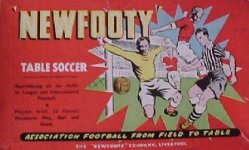
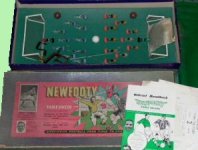
| Peter Upton's |
|
Newfooty Tribute Website. |
|
or 90 Years of Table Football. |
Part 2: The Newfooty Game 1954 onwards. |
This page carries on the history of Newfooty from part 1.
The Mid 1950s.


The new box lid, and a full set (with pitch) from 1957.
In 1954 Newfooty changed the design of the box lid once more. Orange was still the predominant colour, but the action picture no longer covered the whole lid, and featured a goalkeeper in a yellow jersey with players in the colours of Newcastle and Blackpool. The box under this label could be blue or red, and once again there were a variety of sizes of set to choose from. The largest set of the era was similar to Subbuteo's deluxe assembly set, with the players and accessories laid out on a tray and a pitch underneath. The pitches of this era have the "Newfooty" logo emblazoned where the goal stands, and lack a shooting area line, although there are marks on the touchlines to show where the shooting area starts.
The odd thing about Newfooty box lids is that they seem to run in parallel. As mentioned, there was a big collection on Subbuteoworld in 2023, which allowed for a bigger selection of sets to be studied. Whilst this backed up my date of 1954 for the first sets with this new label, the old "Invented 1929" label was still stuck to sets with paperwork in every year up to 1957-58. The yellow box shown below also debuted in 1957, so in effect all three labels appeared together. Existing stock? Shop stock versus mail-order stock? It is a bit of a mystery. You could argue that Newfooty was perhaps a more "amateur" production than rivals Subbuteo.
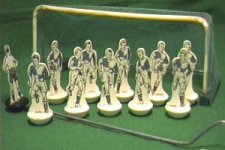

A card team in the late bases in front of yet another type
of goal.
A close up of a celluloid figure in the new base.
Whilst Subbuteo production stayed pretty constant throughout the 1950s, Will Keeling was still tinkering with his design, or perhaps that is still innovating. In this era the base was tweaked once again. It was still a one piece plastic base with a metal bottom, but the whole base was made slightly larger, with a prominent lip on the rim. These were still steep sided. The metal base visible underneath was no longer flat across the bottom, but had a round indentation in the middle, so less of the base was touching the playing surface. Was this better? Someone thought so. There was a new goal type too, illustrated above. These had metal frames, small wooden side bases and their own instruction sheet. I've seen these in sets as early as 1956-57.
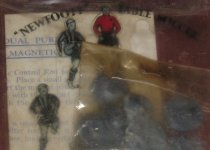
This bagged team is an interesting item, because the assembly sheet explains that is was dual purpose and magnetic. The metal in these bases is obviously not lead, and they are magnetized so that they can also be used in Newfooty's magnetic game "Socrates". See the Keeling Games page for more details.
The final Newfooty Company Sets. 1957-61.
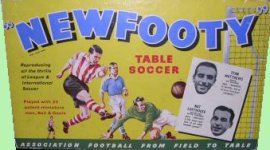
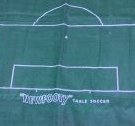
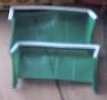
In the final few years of production, Newfooty box sets were produced with an attractive yellow lid, featuring Sunderland and Man City, as well as the standard quotes from Nat Lofthouse, and Stan Matthews. By this point, the sets sometimes featured all plastic goals, with white posts that clipped onto a moulded green net, but as with all Newfooty production, the earlier goal types also appeared. As before, it was possible to buy a small basic set, or a bigger version complete with pitch. The box of the full edition also featured quotes from two Scottish internationals, George Young (Rangers) and Lawrie Reilly (Hibernian). The company also changed address at this time to Primrose Street, Liverpool 4.
The Player's Association.
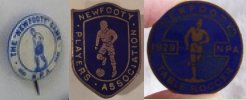
Like Subbuteo, Newfooty had a Players Association (simply the NPA) designed to bring owners together, and encourage competition. A Silver Cup is mentioned in the literature (as usual with Newfooty, stressing that this predated Subbuteo's version!). Sadly, I do not have too many details on how the NPA was run. Sets sometimes have the application forms, or a membership card. Strangely, collector Ashley Hemmings spotted these three previously unseen NPA badges in a matter of weeks on ebay. The white badge seems to be a pre-war version, whereas the "1929" badge on the far right matches the sets of the late 1940s, early 1950s, when the rivalry with Subbuteo was simmering.
New Footy's Other Sport Games.


The boxes for Newcrikit and Pel-Mel.
Following Subbuteo's lead for once, the Newfooty Company also produced games based on other sports. I guess this is where having a generic name like "Subbuteo" benefits over calling your company "Newfooty". Nevertheless, among the other games Will Keeling produced were Net-a-ball a table netball game with card figures and a tiddlywinks feel, New Crikit, which was similar to Subbuteo's cricket game but had running batsmen, Pel-Mel a horse racing/steeplechase game, and showjump, a show jumping game (rather obviously!). New Crikit items appeared in the 1957-58 Newfooty price list, but otherwise there is little cross-over beyond advertising leaflets.
These games are shown on a separate page - "Keeling's Action Packed Games."
1961-64 Two endings. Crestlin and the 3-D Figures.
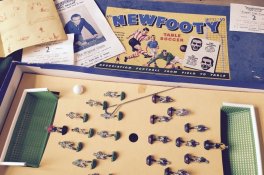
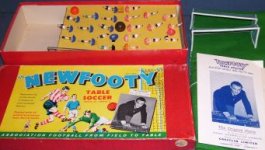
In 1961, the fortunes of Subbuteo and Newfooty took very different paths. The first Subbuteo sets to feature OO scale teams appeared just in time for Christmas of that year. Whether they knew it or not, these sets were to make the Subbuteo brand famous throughout the world. By contrast, 1961 was the year in which the original Newfooty Company had to vacate its premises and cease trading.* At first glance, it looks as if the OO scale figures finally finished off Newfooty, but Will Keeling's firm was in trouble before these sets came out and probably succumbed to the usual cash-flow problems that small businesses have. There is an oft-told tale is that Keeling had stocked up on sets in anticipation of an expensive TV advertising campaign. He had previous success with an advert in the local Granada area, and was expecting a good response from a nationwide advert (Subbuteo also advertised on TV in this period). Then the TV schedulers changed programmes at short notice, Mr Keeling's advert did not reach the intended audience and the response was poor.** On top of this, the company was faced with a large tax bill, and with all their monies tied up in stock, this could not be met. So farewell to the Newfooty Company.
However, Will Keeling was not going to give up on his baby that easily, and so a new company "Crestlin Ltd" was formed to sell his range of games once more. Crestlin has a new address of 33-35 Longmoor Lane, Liverpool 9. Alas, Newfooty had lost too much ground to Subbuteo, and this new endeavour lasted only a year or two before folding once more. 1963-64 seems like the final season for Crestlin and for Newfooty.
* I've always understood that Newfooty folded in 1961. In the
big Subbuteoworld collection sold in 2023, there were 1960-61 and 1961-62 sets
with Newfooty Company price lists to back that up. However, there was also a set
with a 1959/60 Newfooty rule book mixed with Crestlin paperwork (and the
Longmoor Lane address for the Newfooty Association). This does show you can't rely on the paperwork 100%,
especially if Crestlin were using up old supplies, which was probably the case.
**I believe that sources close to the Keeling family have since said that the
whole "TV advertising" story relating to the collapse is basically nonsense.
The most interesting thing about this final fling for Newfooty was the fact that OO scale sets were offered. The 1963/64 price list showed the following sets.
| Set No. 0 | Card teams etc |
| Set No. 1 | Celluloid teams, netted goals etc. (although the all plastic goals were often included). |
| Set No. 2 | Set 1, but with 3-D teams. |
| Set No. 3 | Set 2, plus pitch. |
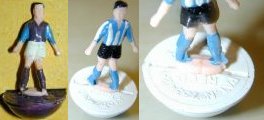
The Newfooty 'OO' scale figures were apparently planned before the collapse of 1961. In fact, they may have actually been released under the Newfooty Co banner in 1961. They were used in the standard Newfooty bases, and could be supplied un-painted, or painted to order. Conventional wisdom had it that these figures were only made in a very limited run, and that Sets two and three were never officially produced. However, the wonder of ebay has enlightened us, and several full 3D sets have been sighted in the last few years. The sets were all the standard yellow lid of the time, although the box colour can vary. It is usually blue, but red has been seen.
The story told about these figures is that they were designed in an "action pose", like the celluloid flats. However, their ankles were too weak and so the figures prone to breaking. The pictured figure shows a player close to the Subbuteo version in style, but with an odd bendy legged stance. The figure ill-fits the old style of Newfooty base, and the legs are indeed extremely fragile.
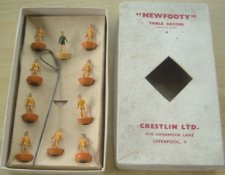
Not only were the 3D figures produced in sets, but they were also sold as separate teams. This picture of an all yellow team in a printed "Crestlin Ltd" box was the first one I had seen. The Crestlin address at this time was 33-35 Longmoor Lane, Liverpool 9. The look of the set is remarkably similar to the Subbuteo team and box of the same vintage.
Like Subbuteo of the time period, the Crestlin price list of 1963/64 included card, celluloid and 3D figures. However, unlike Subbuteo, all the figures used the same bases. The Crestlin 3D figure could be purchased unpainted, and un-based.
| Ref No 1963/64 | Description | Price 1963 |
| 1 | Set of 11 plastic, self balancing bases with fitted stabilisers. For use with Refs 2, 3 and 4 | 2s 9d |
| 2 | Set of 11 card-board figures, in sheet form, punched out. | 9d |
| 3 | Set of 11 all-action celluloid plastic figures, in sheet form, punched out ready for use. | 3s 3d |
| 3-D | Set of 11, plain 3-D figures for self painting. | 3s |
| 4 | Set of 11 three-dimensional moulded plastic figures, hand-painted. Sensational addition to our range. Available in any requested coloures. A "Must for all soccer enthusiasts. | 4s 11d |
| 5 | Complete cardboard team - figures and bases | 3/6 |
| 6 | Complete celluloid team - figures and bases | 6/0 |
| 7 | Complete plastic 3D team and bases. Fully assembled in presentation box (Shown above). Available from September 1962. | 9/3 |
When Crestlin folded, the stock was sold off to pay debts. To quote Glyn Willams' history of Newfooty once more, "WH Adamson bought it (as main creditor) and subsequently sold it to Subbuteo Sports Games who then made it obsolete in their own interest". This sounds reasonable, but is it that simple?
The Mystery of Peter Adolph and Newfooty.
As I've mentioned above, the Newfooty stock ended up in the hands of its biggest rival. Richard Payne states in his Subbuteo book that "Peter Adolph claimed to have bought out the company through one of his subsidiaries.." There are various rumours of the fate of New Footy once it was owned by its long term rival. You can certainly imagine Peter Adolph's satisfaction at finally owning the competition. However, the simple "SSG burnt the lot" theory*** doesn't explain these few bits of evidence that remain.
1. A Newfooty figure in Charles Stadden's invoices.
As mentioned elsewhere on this site, Charles Stadden was the pattern maker who produced many of the OO scale figures for Subbuteo. He didn't design bases, but he did do the cups (so see below). In Mr Stadden's 1960s invoices are various football figures designed for Subbuteo, but this one stands out.
6th August 1964. Subbuteo Ltd "New Footy" figure. "OO" gauge pattern figure carved and engraved in white metal as per instructions and pattern supplied. Football player standing. £10
So this was a Newfooty figure designed for Subbuteo after Crestlin had ceased trading. It certainly backs up the 1963-64 season as being the final one for Crestlin.
2. The Peter Adolph "Newfooty 4-2-4" advertising leaflet.
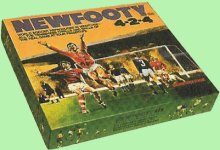
This item was ordered by Mr Adolph around 1968, and the address on the brochure is Tunbridge Wells. The game was to be called "Newfooty 4-2-4", but the testimonials to the game that are quoted in the booklet seem to be from the Will Keeling era. The year 1968 is a key date, because Peter Adolph reluctantly sold Subbuteo Sports Games to Waddingtons in April of that year. Although he became Managing Director of SSG under Waddingtons, frictions caused Peter Adolph's resignation in 1970. In the 1970s Peter Adolph experimented with other football games, and is it possible that this use of Newfooty was an early example of this?
It is also worth mentioning that another football game produced in the late 1960s was Table Association Football (T.A.F.) 4-2-4, which now has its own Table Association Football 4-2-4 page.
The brochure offered three sets with a very "subbuteo-like" feel to them; Super League, European Cup, and World Cup. The artwork on these mock-up boxes will be very familiar to any 1970s Subbuteo players who longed for a Munich set, or owned a Targetman set, as the same picture is used.
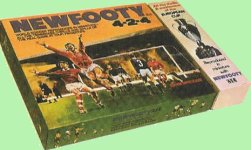
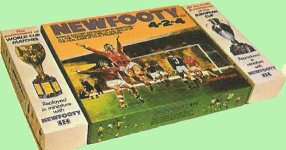
| Super League | featuring "two mini-scaled plastic teams in the colours of famous clubs, playing pitch. goals, and balls" |
| European Cup | Super League plus plastic surround and replica of the European Cup. |
| World Cup | European Cup Set plus footballer statuette, corner flags, and replica of the World Cup. |
It is worth noting that the Charles Stadden invoiced Subbuteo Sports Games Ltd for his work on the footballer Statuette in February 1967 and for the World Cup, and European Cup in March 1967.
3. The Newfooty 4-2-4 base.
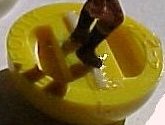
Peter Adolph progressed further with this project than just an advertising leaflet. As shown above, the standard Subbuteo rugby base has been sighted with "Newfooty 4-2-4" embossed around the rim. So this base was obviously originally designed for the game Peter Adolph was advertising in his leaflet. I've only seen these embossed bases with standard heavyweight Subbuteo figures in them, and painted to rugby colours. The heavyweight was introduced to Subbuteo circa 1967, and the rugby game itself seems to appear around 1968 or 1969. It has been suggested that the actual rugby playing figure was the "second generation" Newfooty 3-D figure, but I'm not sure whether this was the case. Perhaps it was the figure produced by Charles Stadden as mentioned above. Certainly the "rugby" figure does turn up in Subbuteo Club Editions dated 1967, where it appears in football strip, with the moulded short sleeves painted as such.
4. A letter to sales director Geoffrey Samson - Spring 1976.
Long after Waddingtons had bought Subbuteo, and Peter Adolph had left the company, there was a final mention of the game. As Daniel Tatarsky explains in his book Flick to Kick (2004) "sales director Geoffrey Samson suggested a new mass market football game to be sold through chains and supermarkets... Victor Watson, Waddingtons chairman wrote in a letter 'I like the idea in principle although the name Newfooty turns me right off'".
*** There is an urban myth that Peter Adolph had a fire at the Newfooty factory to burn all the old stock. It has been pointed out that the final Newfooty address was the Keeling family residence, so like the TV advertising story, this is clearly a tall tale. It might be tied into an apparent clear-up at Subbuteo's factory, where they destroyed their own old 1950s stock that they were no longer selling, such as the space/racing games (that makes you sob!)
That sadly, is about the last we hear of the wonderful Newfooty, although there were apparently a couple of attempts to re-launch the game in the 1980s and 1990s, with prototypes being produced. A Player's Association in the North of England kept the game alive for many years after production had ended (and I hope they are still doing so!)
1990s Newfooty Sets.
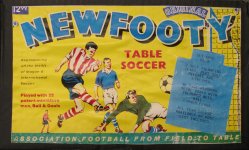
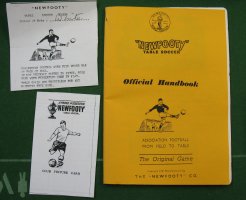

July 2015:- Two late 1990s Newfooty sets with a very "home made" feel passed through ebay this year. They showed how enthusiasts had kept the game alive after it had ceased to be produced. It stands to reason that the 1950s sets and spares were going to become increasing scarce, and if the game was to be played (and grow), then new products would have to be made available.
As mentioned, these sets are quite "do-it-yourself", although to be honest, that does reflect back to the original Keeling sets with their painted lead bases, and net curtain goal covering. Illustrated here, the box looks rather impressive, but actually it is just a black shoe box with a printed label attached. The label is copied from a 1960s Newfooty set, and has the word "original" inserted above the Newfooty logo. The original endorsements by 1950s footballers have been replaced by a blue contents list. Apparently, this is set 82, and contains two teams with substitutes, plus referee and linesmen, 30 page handbook, metal goals with coloured nets, corner flags, and a ball. The paperwork and handbook are very old-school - simply typed and photocopied.
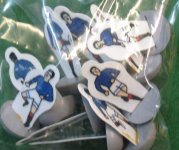

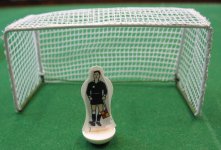
The players are hand-drawn in the correct poses from the original game, and each is numbered. However, the teams themselves are not retro, with the correct 1990s trim (see Rangers above). The players themselves have simply been printed onto paper, which has been glued to a white plastic shaped figure. It makes you think of ice cream sticks, but also of the shape of old Subbuteo flats. The one-piece plastic bases too, bring to mind 1950s Subbuteo more than Newfooty, which always had a performance affecting heavy lead feel. The balls seem more like Newfooty of old however (see picture compared to the standard Subbuteo ball on the right). The goals are metal, so feel robust, although some way of fixing them to a pitch would be useful. The corner flags are metal and tiny.
The Newfooty part of the webite has expanded to included the other Keeling games, and more details on the accessory and team ranges. Pick from the options below, or choose another destination.
[ Main Page ] [ Previous Page ] [ Next Page ]